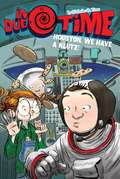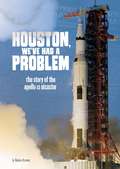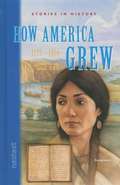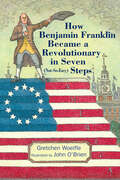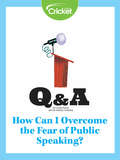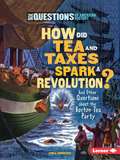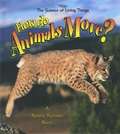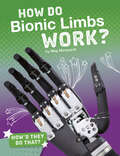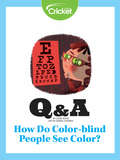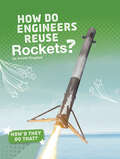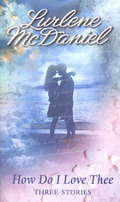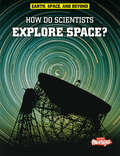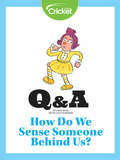- Table View
- List View
Houston, We Have a Klutz!
by Nicholas O. TimeGrace sneaks onto Apollo 11 with a little help from some surprising allies in this fourth wacky novel, part of the all-new In Due Time series."Graceless Grace" is the smartest seventh grader at Sands Middle School, but she's constantly being teased for stumbling over doorjambs and knocking over lunch trays. And lately, the name-calling has been even worse. So when Ms. Tremt offers to lend The Book of Memories to Grace for an extended trip, she decides to go completely out of this world. She travels back to 1969 to stow away on Apollo 11 and become the first kid, the first female, and maybe even the first person to walk on the moon. Take that, teasers! Sneaking onboard Apollo 11 without messing up the mission requires some serious brainpower. Luckily, Grace has something NASA doesn't--a time portal. She opens up The Book of Memories and assembles her dream team: Isaac Newton, Albert Einstein, and Hypatia of Alexandria, and works with them to reduce the cargo just enough to safely board the rocket. Apollo 11 leaves the atmosphere with 6,099,920 pounds of space ship and eighty pounds of middle school girl. Grace impresses Neil Armstrong with her smarts and dazzles the world with her spacewalk. After all, you can't face-plant in zero gravity! But when Grace returns to the present, she's dismayed to discover NASA has covered up her historic achievement. There is no mention of her in history books, no record of her spacewalk. Some things in history can't be changed, explains Ms. Tremt, but people can change. And now, "Graceless Grace" has the confidence to redefine her reputation!
Houston, We've Had a Problem: The Story of the Apollo 13 Disaster (Tangled History)
by Rebecca RissmanIn an immersive, exciting narrative nonfiction format, this powerful book follows a selection of people who experienced the events surrounding the Apollo 13 disaster.
How AI Works: From Sorcery to Science
by Ronald T. KneuselAI isn&’t magic. How AI Works demystifies the explosion of artificial intelligence by explaining—without a single mathematical equation—what happened, when it happened, why it happened, how it happened, and what AI is actually doing "under the hood."Artificial intelligence is everywhere—from self-driving cars, to image generation from text, to the unexpected power of language systems like ChatGPT—yet few people seem to know how it all really works. How AI Works unravels the mysteries of artificial intelligence, without the complex math and unnecessary jargon.You&’ll learn: The relationship between artificial intelligence, machine learning, and deep learningThe history behind AI and why the artificial intelligence revolution is happening nowHow decades of work in symbolic AI failed and opened the door for the emergence of neural networksWhat neural networks are, how they are trained, and why all the wonder of modern AI boils down to a simple, repeated unit that knows how to multiply input numbers to produce an output number.The implications of large language models, like ChatGPT and Bard, on our society—nothing will be the same againAI isn&’t magic. If you&’ve ever wondered how it works, what it can do, or why there&’s so much hype, How AI Works will teach you everything you want to know.
How America Grew: 1775-1914
by Nextext Staff Mcdougal-Littell StaffA collection of stories based on historical events in the history of the United States from 1775-1914, including the Lewis and Clark expedition, the Civil War, and the building of the Panama Canal.
How America Works: Understanding Your Government And How You Can Get Involved
by Elliott RebhunLearning about civics shouldn't be boring. How America Works gives teens a fun, behind-the-scenes look at how the U.S. government works, why they should care and how they can get involved. But this isn’t just any old civics primer. Appealing graphics and a conversational tone draw readers in from the very first page. Political cartoons and debates spark critical thought. And age-appropriate explanations make even the most complex civics topics accessible and easy to understand. In short, this comprehensive guide has everything teens need to know about government and civic engagement (and probably don’t).
How Angel Peterson Got His Name: And Other Outrageous Tales about Extreme Sports
by Gary PaulsenGary Paulsen's slapstick tales capture the "wonderful madness" of growing up in a small town in northern Minnesota, when high spirits, showing off for girls, and general idiocy led Gary and his pals to attempt some amazing stunts, including: <P> * Shooting a waterfall in a barrel<P> * Breaking the world speed record on skis <P> * Hang gliding with an army surplus target kite <P> * Inventing the skateboard <P> * Jumping a bike through a hoop of fire <P> * Wrestling with a bear. <P> Wacky, daring, just plain nuts -- extreme sports lead to extreme fun in these stories from Gary's boyhood.
How Benjamin Franklin Became a Revolutionary in Seven (Not-So-Easy) Steps
by Gretchen WoelfleHow did Ben Franklin become an outspoken leader of the American Revolution? Learn all about it in seven (not-so-easy) steps in this humorous, accessible middle-grade chapter book that focuses on Ben&’s political awakening.Famous founding father Benjamin Franklin was a proud subject of the British Empire—until he wasn&’t. It took nearly seventy years and seven not-so-easy steps to turn Benjamin Franklin from a loyal British subject to a British traitor—and a fired-up American revolutionary. In this light, whimsical narrative, young readers learn how Franklin came to be a rebel, beginning with his childhood lesson in street smarts when he buys a whistle at an inflated price. Franklin is a defiant boy who runs away from his apprenticeship, and while he becomes a deep thinker, a brilliant scientist, and a persuasive writer when he grows up, he never loses that spark. As a community leader who tries his best to promote peace and unity both between the colonies and with Great Britain, he becomes more and more convinced that independence for the American colonies is the way forward.Illustrated throughout with art by noted New Yorker cartoonist and illustrator John O&’Brien and sprinkled with quotations from Franklin, this unfamiliar story of a familiar figure in American history will surprise and delight young readers.
How Can I Be a Detective If I Have to Babysit?
by Linda BaileyDetective Stevie Diamond and her partner, Jesse Kulniki, take off for her dad's tree-planting camp in desperate need of adventure. What they find is a job taking care of five-year-old Alexander Creely. It's insulting! Stevie is steaming until she hears about Rubberface Ragnall--a smuggler who has been ransacking Alexander's trailer. Suddenly, baby-sitting seems the perfect job for the Diamond and Kulniki Detective Agency.
How Can I Overcome the Fear of Public Speaking?
by Lizzie WadeSome people are afraid of public speaking more than others. Learn about some surprising ways to overcome stage fright.
How Can Some People Be Good at Singing?
by Lizzie WadeSome people are better at singing than others. Why is that? A researcher explains why some people love doing karaoke, and others simply can't do it.
How Come?: Every Kid's Science Questions Explained
by Kathy WollardFact-filled, fun-filled, as interesting to parents as it is to kids, the How Come? series is the trusted source for lively, clear answers to kids’ science queries. Now the best questions and answers from all three books—How Come?; How Come? Planet Earth; and How Come? In the Neighborhood—have been revised, updated, freshly illustrated in full color, supplemented with twenty completely new questions, and combined into one bigger, better volume. How Come? explains, in fascinating detail, more than 200 mysteries and phenomena in the world around us. These are the questions that pique kids’ curiosity—and stump parents.When it rains, does running (rather than walking) to the nearest shelter really keep you any drier? How can a stone skip across a pond (instead of sink)? If the Earth is spinning, why can’t we feel it? Why don’t we fly off? Why do elephants have trunks? And the all-time classic, Why is the sky blue? (Sunlight has a hidden rainbow of colors, and air molecules scatter blues the most—sending bright blue light down to Earth.) The text is clearly written, engaging, and accessible. It’s for every kid who wants to know—and every grown-up who simply doesn’t know.
How Did Humans Go Extinct?
by Paul Hoppe Johnny MarcianoLet’s learn about the most mystifying species to ever walk the Earth!“A clever . . . way to bring awareness to the very real threats to humanity posed by war, climate change, and capitalism. A compelling and unique dystopian sci-fi picture book for early school age readers, this is recommended for all collections.” —School Library JournalPlib is like every other Nøørfbløøk kid on Earth, except for one thing.He loves humans—those horrible, terrifying monsters who dominated the planet ten million years ago.Only one thing about the humans bothers Plib. What happened to them all? Did they turn the planet into an uninhabitable wasteland? Or did they turn on each other? Or did the humans die out because of something else they did—or didn’t—do?Find the answer in How Did Humans Go Extinct?
How Did Robots Land on Mars? (How'd They Do That? Ser.)
by Clara MacCaraldAfter traveling millions of miles through space, roving robots gently landed on Mars and then drove across its surface. Read this book to learn how engineers accomplished these amazing feats of space exploration.
How Did Tea And Taxes Spark A Revolution?: And Other Questions About The Boston Tea Party (Six Questions Of American History)
by Linda GondoschOn a cold evening in December 1773, a group of men climbed aboard three ships docked in Boston Harbor. Armed with hatchets, the men began breaking into the ships’ valuable cargo―342 crates of tea. They dumped the tea into the black water of the harbor and then marched back home through the city streets. This “Boston Tea Party” was a bold act of protest by American colonists against British rule. It pushed the colonies and Great Britain a step closer to war. But who were these protestors? Why would they risk angering the powerful British government? And how did the British respond? Discover the facts about the Boston Tea Party and the colonists’ struggle for independent rule.
How Do Animals Move?
by Bobbie Kalman Niki WalkerSlithering snakes, jumping kangaroos, flying albatrosses, and swimming salmon--every animal, including humans, has its own unique way of getting around. This beautiful new book explains the how, why, and "are we there yet?" of animals large and small across the globe. Topics include: *how an animal's environment affects its movement *how an animal's skeleton affects its movement *unusual animal movers such as the water-walking basilisk *how a parent helps its young move around
How Do Bionic Limbs Work? (How'd They Do That? Ser.)
by Meg MarquardtPeople who lose limbs now have incredible options to help them walk and do other everyday activities. Read this book to learn how engineers are creating bionic limbs to help patients.
How Do Color-blind People See Color?
by Lizzie WadeTo understand what it means to be color-blind, you must first understand how most of us see color.
How Do Engineers Reuse Rockets? (How'd They Do That? Ser.)
by Arnold RingstadReusable rockets are making space travel cheaper and more common. Read this book to discover how engineers bring huge rockets to a safe, gentle landing.
How Do I Love Thee
by Lurlene McdanielThough written more than a century ago, Elizabeth Barrett Browning's beautiful sonnet rings true today for three young couples who believe in the power of love. <P> In "Night Vision," Brett finds a way to brighten a special girl's lonely existence.<P> "Bobby's Girl" features Dana, who must choose between two brothers, both of whom she loves.<P> "Laura's Heart," the third story, introduces 16-year-old Laura Carson, who is hospitalized on a regular basis because of her weak heart. But when tragedy strikes a loved one, she realizes her heart is stronger than she thought and that love lives on forever.
How Do We Elect Our Leaders? (My American Government)
by William David ThomasIn what ways are the branches of government like a basketball game? How can a school yard game's rules liken themselves to a constitution? Through engaging analogies and introductions, our new government series gets students ready for election 2008. Correlated to the fourth and fifth grade social studies curriculum, My American Government introduces students to how our government works. Students learn about the U.S. Constitution, the branches of government, citizens' basic rights, and how we elect our leaders.
How Do We Sense Someone Behind Us?
by Lizzie WadeHow do humans sense when someone is behind them? This Q & A explains the science of peripheral vision.
How Do You Go to the Bathroom in Space?: All the Answers to All the Questions You Have About Living in Space
by William R. PogueHave you ever wondered what it's really like for an astronaut in outer space? From the exciting moments to the day-to-day details, from the serious to the humorous, you'll find answers to every question you've ever had about living in space!What does it feel like to be weightless? Would a sneeze propel you backward? What happens to your body in space? And, most importantly, how do you go to the bathroom in space?Find out the answers from the astronaut who for more than a decade held the world record for the number of days spent living in space!To take advantage of the renewed interest in space travel, thanks to the success of Packing for Mars, this re-release of the bestseller (with over a quarter million copies in print) features a fresh look, dozens of authentic NASA photographs, and an introduction by John Glenn.At the Publisher's request, this title is being sold without Digital Rights Management Software (DRM) applied.
